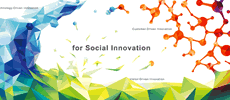Hitachi-AIST Circular Economy Cooperative Research Laboratory: Second Open ForumIdeal Future of the Circular Economy and What is Needed to Get There?
Highlight
Amid increasing efforts in Japan and elsewhere to make a transition away from the linear economy of the past and toward a circular economy, Hitachi and the National Institute of Advanced Industrial Science and Technology (AIST) are working together to consider what a future circular economy should look like and the rules and solutions that will be required to realize this vision. This study is taking place at the Hitachi-AIST Circular Economy Cooperative Research Laboratory that was launched jointly in 2022 to focus on three research topics, the formulation of a grand design, the development of digital solutions, and the development of standardization strategies.
The first open forum was held in 2024 with the aim of fostering mutual understanding with other interested parties about the nature of the problem by considering what forms a future circular economy might take and by identifying the technical and institutional challenges to achieving it. Following this, a second open forum was held in February 2025 to present the laboratory’s findings about what a future with a circular economy should look like and about the technologies and rules needed to get there. The forum also hosted a panel discussion with invited experts to debate the requirements for achieving a circular economy and what sort of rules to adopt to encourage behavior change by individuals and companies.
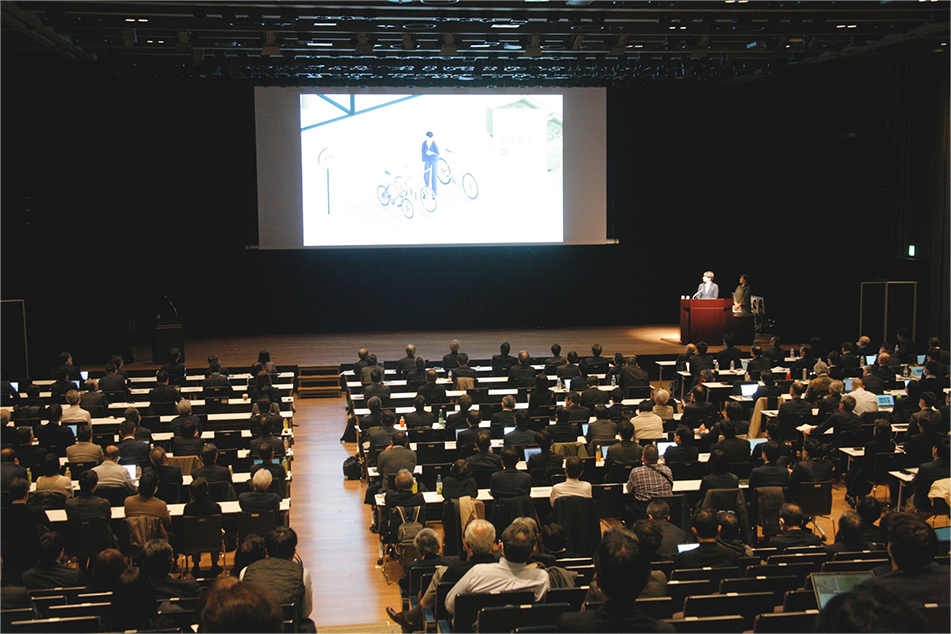
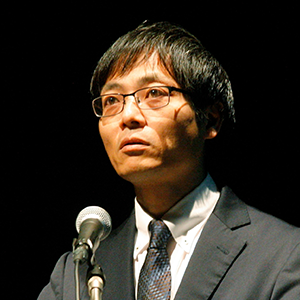 Moderator
Moderator
Terada Shohei
Deputy Director, Hitachi-AIST Circular Economy Cooperative Research Laboratory,National Institute of Advanced Industrial Science and Technology
Amid concern about depletion of the resources essential to daily life and business, efforts are growing around the world to achieve a transition away from the linear economy of the past that was predicated on products being both produced and disposed of in high volume and toward a circular economy (CE) that circulates resources through measures such as recycling and remanufacturing. It was against this background that the Hitachi-AIST Circular Economy Cooperative Research Laboratory (the Hitachi-AIST CE Lab.) held its second open forum in February 2025 on “Ideal Future of the Circular Economy and What is Needed to Get There?” How society can achieve an ideal CE is one of the laboratory’s research topics. The forum was hosted by Terada Shohei, Deputy Director of the Hitachi-AIST CE Lab.
1. Opening Address
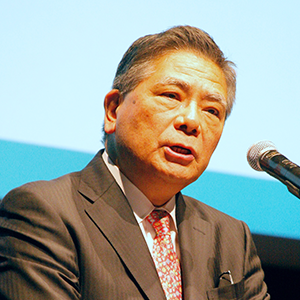 Kazuhiko Ishimura
Kazuhiko Ishimura
President and CEO, National Institute of Advanced Industrial Science and Technology
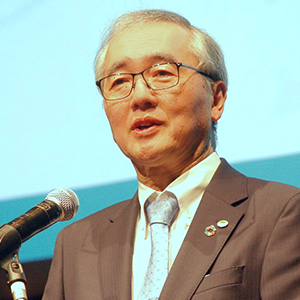 Keiji Kojima
Keiji Kojima
President & CEO, Hitachi, Ltd.
The forum’s opening address was given by Kazuhiko Ishimura, President and CEO of the National Institute of Advanced Industrial Science and Technology (AIST). Touching on developments in the CE sector that have taken place both in Japan and overseas in the year since the previous open forum, he noted that, “A CE is not something that can be brought about by a single company or research institution acting on its own. If CEs are to become a reality, it is crucial that ecosystems be established that can foster innovation collaboratively with organizations from a range of different standpoints working together, including diverse companies, research and educational institutions, investors, and governments.” He also summarized the day’s program and thanked the audience and presenters.
Next, Keiji Kojima, President & CEO of Hitachi, Ltd., spoke about the importance of utilizing open source to achieve a CE and acknowledged the significance of the forum. “Key to society establishing a CE will the open sharing of technologies and expertise between a wide range of stakeholders, as is found in the open source community. The reuse of existing goods encourages the use of resources and energy without waste and the efficient production of improved goods. I hope that the discussions that take place at today’s open forum will facilitate a cycle of knowledge exchange and different ways of thinking.”
2. Special Presentation
Developments in CE Standardization and What Japan Hopes to Achieve
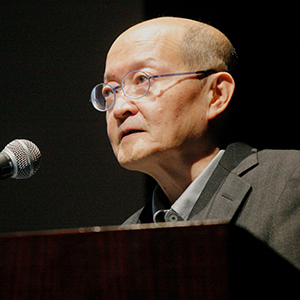 Yoshiaki Ichikawa
Yoshiaki Ichikawa
Visiting Professor, Tama University and former international convener of ISO/TC323/WG2
Next was a special presentation by Yoshiaki Ichikawa, a Visiting Professor at Tama University and a former international convener of ISO/TC323/WG2. Professor Ichikawa spoke about progress on the international standardization of CE in Japan and overseas, the prospects for the future, and Japan’s strategy.
Professor Ichikawa began with a summary of the work being done by ISO/TC323, the only international standardization body addressing CEs at the International Organization for Standardization (ISO). He reviewed three new standards issued in May 2024, (1) ISO 59004 “Vocabulary, principles, and guidance for implementation,” (2) ISO 59010 “Guidance on the transition of business models and value networks,” and (3) ISO 59020 “Measuring and assessing circularity performance,” explaining the work that went into their formulation and what various countries are doing in this area.
The ISO 59004 standard that defines CE concepts and vocabulary defines a CE as “an economic system that uses a systemic approach to maintain a circular flow of resources by recovering, retaining, or adding to their value, while contributing to sustainable development.” Professor Ichikawa stated that businesses in a CE will need to transform their existing value chains into value networks that are based on shared objectives, strategies, and plans, noting that the implementation of appropriate governance will be crucial if they are to achieve exponential growth through these value networks. He also noted that indicators from the resource input and output sides will both be vital for assessing outcomes, such as the mean rate of reuse for inputs on the input side and the percentage of reuse products or parts derived from waste that are actually reused on the output side. Alongside mandatory indicators, optional indicators that are easy for consumers to understand can likewise fulfill an important role, such as the mean life of products or materials, for example.
The latter half of his presentation previewed a new ISO/TC323 project that Japan is proposing in 2025 entitled “Guidance on establishing value networks,” also covering the proposed key performance indicators (KPIs). He also spoke about what Japan should be seeking to achieve in the future, having the following to say about the importance of what position Japan should take with regard to its true goals.
“While Japan was the first country in the world to start talking about circularity and a society based on the cyclic use of resources, unfortunately it was Europe that came up with the definition of “CE.” Whereas the goal of the Europeans is to work toward a CE in which the industry structure suits the nations of Europe, Japan is not able to follow the same path. In terms of industrial policy, the debate needs to include due consideration of the question of what sort of CE would suit the structure of industry in Japan. I believe that the key to CE lies in exit strategies for the creation of high added-value in business. While Japan engages vigorously in activities on the “downstream side” of the CE loop, namely disassembly, dismantlement and sorting, no exit will be available unless we also put effort into the corresponding “upstream side” of the CE loop such as manufacturing, sales, and product use. What is needed are strategies that use collaboration to generate high added-value with sharing of information and ideas on how to develop marketable products on both sides of the loop, both the upstream and the downstream sides.
3. Presentations from Hitachi-AIST CE Lab.
In the session that followed, the Hitachi-AIST CE Lab. Director Katsumasa Miyazaki gave an overview of the laboratory’s activities that was followed by reports on the research being done and the outcomes delivered on the topics of, “Exploration of future scenarios for a CE society using a scenario simulator,” “Indicators for achieving a CE,” “Development of digital solutions that will help the transition to CE business,” and “Japanese efforts on the international standardization of CE to boost its global competitiveness.”
Presentation 1
Overview of Hitachi-AIST Circular Economy Cooperative Research Laboratory Activities
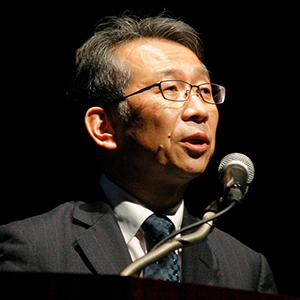 Katsumasa Miyazaki
Katsumasa Miyazaki
Director, Hitachi-AIST Circular Economy Cooperative Research Laboratory, National Institute of Advanced Industrial Science and Technology
In presenting AIST’s global achievements in sustainability research and the research and other activities being undertaken at the Hitachi-AIST CE Lab to put Hitachi’s advanced digital technologies to work on realizing a CE, laboratory director Katsumasa Miyazaki identified the following three challenges to be addressed in achieving a CE.
- The promotion of public awareness of how reusing resources facilitates economic growth
- The creation of digital solutions for enhancing environmental and economic value, and examples of their use
- Strategies for rule-making that take account of different regional considerations without putting Japan at a disadvantage
The Hitachi-AIST CE Lab. has chosen three research topics through which it is addressing these challenges, namely the formulation of a grand design, the development of digital solutions, and the development of standardization strategies.
With numerous countries accelerating their efforts to establish legal and policy frameworks for achieving a CE, there is growing international recognition of the importance of value networks that foster value creation through resource circulation. Ongoing activities in Japan include the establishment of a ministerial conference and the formulation of a policy package for the transition to a CE.
Speaking about future action on achieving a CE, laboratory director Katsumasa Miyazaki made the case that we should treat the current dynamic environment of ongoing change as an opportunity and so need to be considering flexible policies. In anticipation of the Society 5.0 era in which cyber-physical systems (CPSs) are used both to resolve societal challenges and to boost economic development, he advised that we should be seeking to make efficient and cyclic use of the mutually interdependent resources represented by materials, energy, and information or knowledge.
Presentation 2
Exploration of Future Scenarios for CE Society Using Scenario Simulator
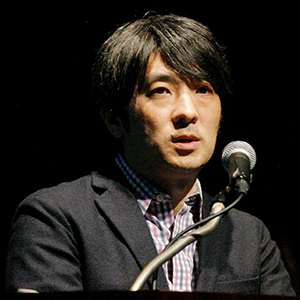 Masahide Ban
Masahide Ban
Manager, UX Design Department, Design Center, Research & Development Group, Hitachi, Ltd.
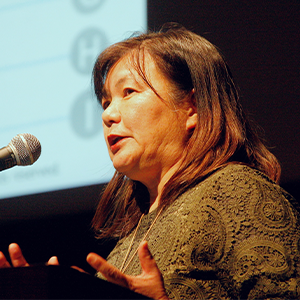 Yukiko Morimoto
Yukiko Morimoto
Chief Researcher, Strategic Design Department, Design Center, Research & Development Group, Hitachi, Ltd.
In the second presentation, Masahide Ban and Yukiko Morimoto, both of Hitachi, Ltd., spoke about the development of a grand design, one of the main research topics being worked on at the Hitachi-AIST CE Lab. They summarized the goals and activities of future scenario simulations being undertaken to study both possible and ideal futures for creating a human-centric society with a high level of resource circulation.
The objective of these future scenario simulations is first to determine how the possible futures identified by past research might be achieved and the challenges that could arise along the way, and then to use these findings to identify which of the scenarios represent an ideal future.
A collection of 20,000 scenarios was first sorted into nine groups and the branching and other factors likely to influence their realization were studied to identify the most desirable scenarios (those where society acquires mechanisms that keep behavior and circulation in harmony). The next step involved discussions with experts to identify the requirements. These addressed the questions of what institutional regulations and practices and what technologies would be needed to bring these scenarios about, and the dates by which they would need to be in place. By doing so, they defined an ideal future as one in which society works in ways that include diverse value systems while encouraging the cyclic use of resources through life extension.
The presentation was followed by a short video that gave an idea of what such an ideal future might look like. Future plans include devising a roadmap for the achievement of a CE and the testing of various hypotheses, including work on topics such as the design of incentives that will motivate stakeholders.
Presentation 3
Indicators for Achieving CE
 Masashi Gamo
Masashi Gamo
Team Leader, Research Institute of Science for Safety and Sustainability, Department of Energy and Environment, National Institute of Advanced Industrial Science and Technology
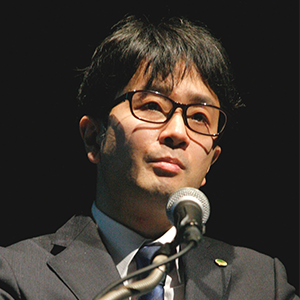 Masahiro Ito
Masahiro Ito
Chief Researcher, Green Process Research Department, Production Engineering and MONOZUKURI Innovation Center, Research & Development Group, Hitachi, Ltd.
With increasing action aimed at achieving a CE across a range of fronts in industry, including in the activities, products, and services of corporates, efforts are also underway to establish indicators for assessing the benefits and progress of this work at a national or regional level. In the third presentation, Masashi Gamo of AIST and Masahiro Ito of Hitachi, Ltd. discussed the perceived challenges associated with the choice of these indicators and reported on how their formulation and analysis is progressing.
If society is to achieve the ideal future, it is essential that all stakeholders choose indicators that are appropriate to their own activities. Hitachi-AIST CE Lab. itself recognizes how important it is when selecting indicators to be aware of how the different indicators relate to one another. After first cataloguing 770 indicators obtained from diverse sources, it consolidated these down to 45 core indicators. It then identified five metrics relevant to an “ideal future,” namely (1) CE market size, (2) reductions in greenhouse gas (GHG) emissions in the value chain, (3) percentage of reused materials on the input side, (4) percentage of reuse on the output side, and (5) final quantity of disposed waste, and collated the relationships among these related indicators. By doing so, it became clear that these indicators interact with one another. When selecting indicators, it is important for each stakeholder to consider the following three important points.
- Identify multiple indicators based on an awareness of how they relate to indicators that constitute an ideal future for society.
- Be aware that efforts to improve specific indicators may have negative impacts on other indicators, and verify these impacts using other indicators.
- It is often useful to select indicators that work across the entire value network.
Presentation 4
Development of Digital Solutions to Support Transition to CE Business
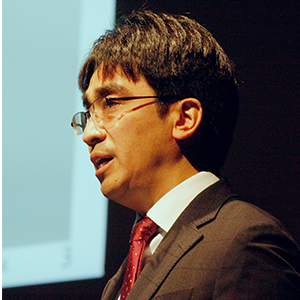 Ippei Kono
Ippei Kono
National Institute of Advanced Industrial Science and Technology
Specified Concentrated Research Specialist, Hitachi-AIST Circular Economy Cooperative Research Laboratory
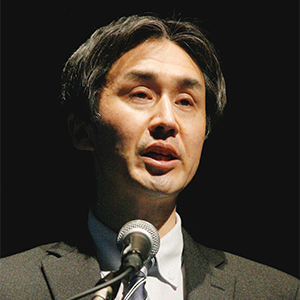 Yoshiyuki Furukawa
Yoshiyuki Furukawa
Team Leader, Industrial Cyber-Physical Systems Research Center, Department of Information Technology and Human Factors, National Institute of Advanced Industrial Science and Technology
Achieving a CE requires solutions for establishing value networks among stakeholders. In the fourth presentation, Ippei Kono and Yoshiyuki Furukawa of AIST described the work being done at the Hitachi-AIST CE Lab. to develop digital solutions.
Having identified the choice of appropriate circulating practices for resources and the use of actual data to assess environmental impacts as two issues that need to be addressed, Hitachi-AIST CE Lab. is developing solutions to address these issues.
The details of each solution are as follows.
- Life cycle simulator to assist selection of appropriate resource circulation
The H-AIST life cycle simulator models the flow of goods and business activities to assess CE indicators and economic value. When the solution was deployed in Hitachi Group businesses, it successfully enabled the evaluation and selection of measures for improving both economic and environmental performance based on quantitative analysis results. - Digitalization of the economy’s “downstream side” of the CE loop so that environmental impacts can be assessed based on actual data
Through digitalization of the “downstream side” of the CE loop where activities like recovery, dismantlement, and reuse take place, this solution can track what is happening throughout product life cycles. Work is progressing on digitalization measures for generating per-unit data on each step in the recycling process.
Hitachi-AIST CE Lab. is utilizing CPSs that incorporate these two solutions to drive the establishment of value networks that will help make CE business a reality.
Presentation 5
Japanese Efforts on International Standardization of CE to Boost its Global Competitiveness
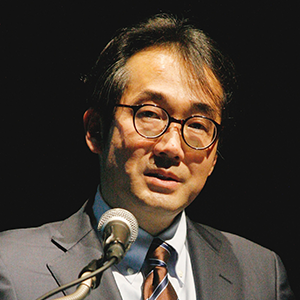 Osamu Hoshino
Osamu Hoshino
Head of Chief Architect Office, Technology Strategy Office, Research & Development Group, Hitachi, Ltd.
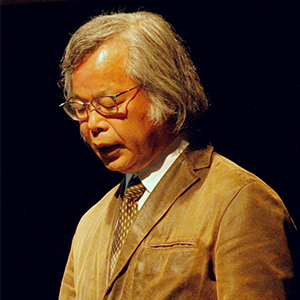 Koshi Kamigaki
Koshi Kamigaki
Standardization Officer, Standardization Promotion Office, Intellectual Property and Standardization Promotion Division, Planning Headquarters, National Institute of Advanced Industrial Science and Technology
A concern with international standardization for CEs is that it will result in rules that are difficult for manufacturers to follow. As such, it is vital that Japan become an active contributor and participant in international standardization to ensure its sustainable growth globally. In the fifth and final presentation of the first half of the forum, Osamu Hoshino of Hitachi, Ltd. and Koshi Kamigaki of AIST described the strategies and future plans for Japan’s involvement in international standardization for the CE sector.
Informed by the needs and challenges of Japanese companies, Hitachi-AIST CE Lab. is working on, (1) developing indicators for visualizing the value generated by contributions to a CE, and (2) promoting standardization of grading to visualize residual value.
- Visualizing value generated by contributions to a CE
The new indicator of “CE value-added productivity” that has been proposed by Hitachi-AIST CE Lab. can be used in conjunction with existing indicators to assess the economics of various CE measures such as reuse, remanufacturing, recovery, sorting, and life extension. Use of this indicator can encourage investment in societal systems and equipment that add significant value with high efficiency. - Grading to visualize residual value
A CE calls for the waste-free circulation of products and materials that provide useful resources. While various work is being done to achieve this by coordinating specification data on products and materials in the “upstream side” of the CE loop and standardizing the indicators and other such measures used in its “downstream side” of the CE loop, the current state of progress is such that a meaningful exchange of data between these upstream and downstream is not yet possible.
To address this problem, the laboratory is proposing the standardization of grading models that provide an objective grade based on information about the product concerned and assessment criteria, utilizing and coordinating existing standards and other such resources for this purpose.
Following discussions and fine tuning of the standard in partnership with other institutions in Japan and elsewhere, a proposed standard will be submitted to ISO/TC323 and other bodies by around March 2026. As such, it represents a practical initiative based on rules and standards devised in Japan.
Panel Discussion
The reports on the work of the Hitachi-AIST CE Lab. were followed by a panel discussion on the topics of, (1) What is the ideal future of the circular economy and what is needed to get there?, and (2) Rules to encourage behavior change by individuals and companies and how to approach standardization.
The first half of the session was taken up with short presentations and personal introductions by the seven expert panelists in which they explained their own take on the two topics. This was followed by a discussion of the topics led by the two facilitators.
Facilitators
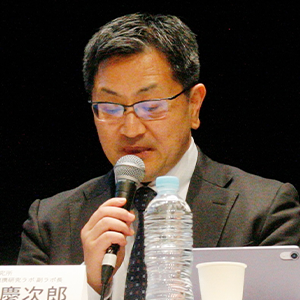 Keijiro Masui
Keijiro Masui
National Institute of Advanced Industrial Science and Technology
Deputy Director, Hitachi-AIST Circular Economy Cooperative Research Laboratory
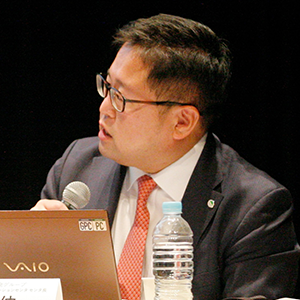 Shinichi Taniguchi
Shinichi Taniguchi
Center Manager, Production Engineering and MONOZUKURI Innovation Center, Research & Development Group, Hitachi, Ltd.
Panelists
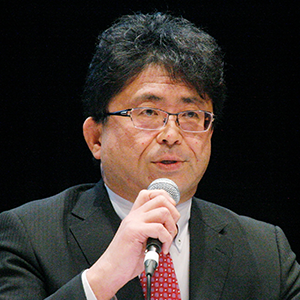 Daisuke Nagasaki
Daisuke Nagasaki
Deputy Director, Resource Efficiency and Circular Economy Division, GX Policy Group, Innovation and Environment Policy Bureau, Ministry of Economy, Trade and Industry
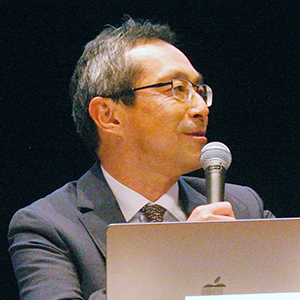 Yasushi Umeda
Yasushi Umeda
Professor, Research into Artifacts Center for Engineering, The University of Tokyo
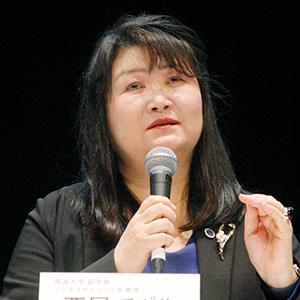 Chizuru Nishio
Chizuru Nishio
Vice President and Professor of Business Sciences, University of Tsukuba
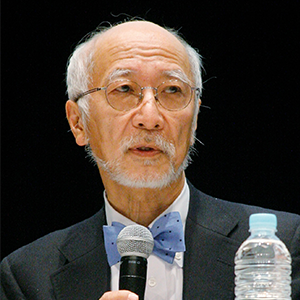 Eiji Hosoda
Eiji Hosoda
Vice Chancellor and Professor, School of Political Science and Economics, Tokai University
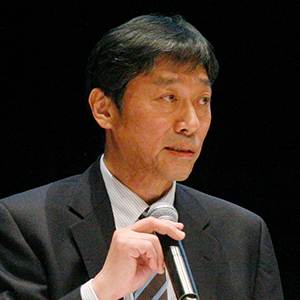 Kazunori Kitagawa
Kazunori Kitagawa
Chief of Eco Management Center, Japan Productivity Center
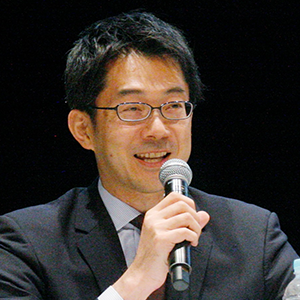 Kotaro Shimizu
Kotaro Shimizu
Unit Head and Principal Analyst, Economic and Industrial Policy Unit, Mitsubishi UFJ Research and Consulting Co., Ltd.
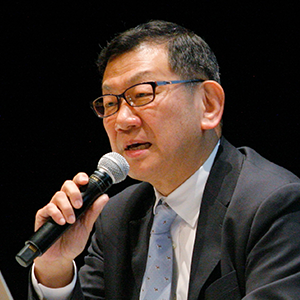 Akio Tajima
Akio Tajima
Circular Economy Expert, Resource Circulation Technology Section, Manufacturing Solutions Center,Manufacturing Innovation Division, Panasonic Holdings Corporation
Topic 1
Ideal Future of the Circular Economy and What is Needed to Get There?
MasuiWhile today’s presentations and reports have introduced numerous key words, including value networks, value, services, and life cycle thinking, what are your thoughts on how the CE differs from recycling?
UmedaI believe that the CE is an effort to make industry more robust. The question I believe we should be addressing at this laboratory is: what sort of industrial structure will deliver the circular use of resources while also improving consumer convenience? The same applies to the design of incentives and we should continually be asking ourselves what lies behind the way that these incentives work.
HosodaThe objectives of a CE are less tangible than those of “reduce, reuse, and recycle” (3R) and collaborative coordination is not easy. Nevertheless, Japan’s underlying strength lies in our playing as a team rather than as individuals. Behind Japan’s success in recycling lie cross-industry connections. While such co-creative capabilities are important when establishing value networks, they do not currently extend to cross-industry cooperation and I believe we should be taking action ourselves before allowing valuable resources to go offshore.
NagasakiOne of the drivers for CE at the Ministry of Economy, Trade and Industry is the work underway on having the participants in industries that are high-volume users of plastics, etc. develop plans for the use of recycled materials that will be built on by working through the plan, do, check, act (PDCA) cycle. For example, plastics are only suitable for cascade recycling due to the quality degradation that comes with their reuse. A CE, on the other hand, involves striving to recycle materials horizontally between different products as much as possible. Achieving this, in turn, requires coordination across the entire value network. Accordingly, my hope is that regulatory changes mandating the use of recycled materials, for example, will prompt action on coordinating the upstream and downstream sides of the CE loop along with work on products and reuse models.
KitagawaWhile CE in Europe does not have a heavy focus on manufacturing, we should be pursuing a Japanese style of CE that leverages the strengths of our manufacturing industry. Manufacturing has already put a lot of effort into the CE. This is because manufacturing is always seeking to extend the life of equipment at its production facilities. Even when products can be repaired in the field, without the skills of manufacturing this will amount to little more than makeshift maintenance. For this reason, I believe we should take on board the idea of adding value in a new way that involves close links with the customer, retaining the connection between vendor and product to support long useful lives for those products.
MasuiNo doubt doing so will raise issues of consumer acceptance and behavior change.
NishioWhere consumers fit into the picture is a key question when engaging in collaborative creation that transcends the boundaries between industries and vendors. While the ideal situation would be one in which companies supply goods and services that take account of the environment and that consumers are keen to purchase and use, in the current environment where there is a growing prevalence of service models that feature sharing or subscriptions, consumers are now able to pick and choose those things that they need, when they need them, based on their own objectives. From a consumer point of view, this is a very materialistic state of affairs. In such an environment, a key challenge will be how to engage consumers as partners in the CE.
Topic 2
Rules to Encourage Behavior Change by Individuals and Companies and How to Go about Standardization
TaniguchiWork on rules and standardization for CEs is happening in various nations and regions, especially in Europe. How do you think Japan should proceed? And what are your views on taking a Japanese approach to rule-making and standardization?
HosodaJapanese people do not emphasize the individual. While there may be certain totalitarian aspects in this, it is also a clear strength that puts relationships at the heart of what we do. It would be a good thing, I believe, if we could develop new ideas that are distinctively Japanese by being based on relationships, including coordination between manufacturing and other industries. In the case of standardization, for example, rather than simply following Europe and America, the proposing of standards that reflect Japanese culture and traditions is an area where I see opportunities arising for Japan.
NagasakiWe are currently proposing value network guidelines on behalf of Japan and I believe it is vital that we present a “Japan model” to the world that involves collaboration between the parties involved and the sharing of solutions. Looking at consumers, our strong tendency to follow the rules is another strength of Japanese people, such as the way we play our part in collection and sorting. Also important in my view is that we convey clearly to consumers that it is through the actions of each of us that effective resource circulation becomes possible.
ShimizuI feel that we can also exhibit our Japanese characteristics through value networks and other corporate groupings. There are new management indicators like sincerity, trust, and nurturing that can measure things not captured by the usual management indicators of sales and profits. Traceability and standards are also likely to be essential when considering questions such as whether we are going about scrap trading in the right way to prevent it from being contaminated by impurities, for example. How to foster the next generation of workers is another important consideration. Before we start laying down rules that restrict what people can do, we should first identify and measure indicators that will give us an insight into the current situation.
TajimaIt is also important, I believe, to loosen up regulation in areas where it is too tight so that we only regulate those things that should be regulated. Rather than being prescriptive, it will help if this involves incentives that encourage people to act on their own initiative. When embarking on something new, such as value networks, the institutional and legal framework is crucial to winning over the parties involved. Accordingly, I hope that the government will support activities like business model development even more than it has in the past. While recycling laws in Japan have been developed separately for different industries, I anticipate that policy measures for accelerating the CE, such as formulating rules on the use of recycled materials that cut across all sectors, will also energize action by business. In this regard, I have very high expectations for the industry-government-academia partnerships that are proceeding in terms of both products and materials, as well as the working groups (WGs) in each area at Circular Partners and the Resource Circulation Economy Subcommittee of the Ministry of Economy, Trade and Industry.
5. Closing Address
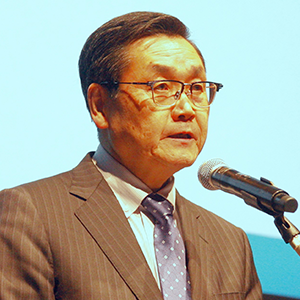 Norimitsu Murayama
Norimitsu Murayama
Senior Vice-President and CTO, National Institute of Advanced Industrial Science and Technology
 Itaru Nishizawa
Itaru Nishizawa
CTO and General Manager of the Research & Development Group, Hitachi, Ltd.
The closing address was given by Norimitsu Murayama, Senior Vice-President and CTO of AIST. He thanked the audience and presenters and made the following comments regarding the presentations and discussions in the day’s program.
“AIST is currently reviewing its research strategy in readiness for our sixth medium- to long-term plan, which will commence from the next fiscal year. We have heard at today’s forum about how the creation of value will be an important factor in society achieving a CE. The AIST Group is working to establish infrastructure for research and development and value creation. Our intention is to put more effort than ever into CE research and development to develop technologies in partnership with the private sector and to see them deployed in society.”
Next, Itaru Nishizawa, CTO and General Manager of the Research & Development Group at Hitachi, Ltd., acknowledged the reports on research work being done by the Hitachi-AIST CE Lab., including the development of a grand design for transitioning society to a CE. He also spoke about the future activities planned by the laboratory.
“The two years and four months since the Hitachi-AIST CE Lab. was established have seen a range of CE initiatives emerging in different parts the world. The activities of the laboratory that started out with a three-year plan will end in September 2025. In conjunction with this, the intention is to produce a report that will cover both the vision for what an ideal future for achieving a CE-based society might look like and the formulation of a roadmap and the technologies to be developed in order to get there. Hitachi, too, is commencing a new Mid-term Management Plan in the 2025 fiscal year and we intend to continue contributing to the realization of a CE society through these activities.”
The information provided in this article including job titles or names of organizations is as of March 2025.

